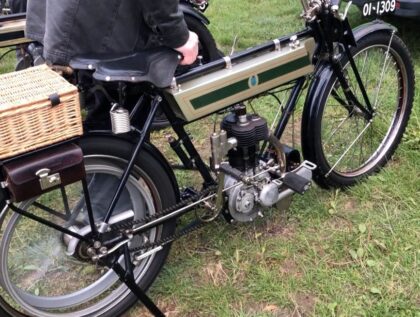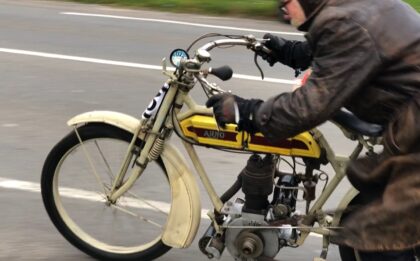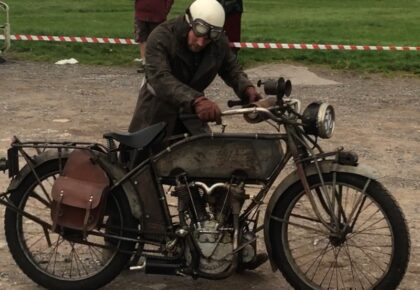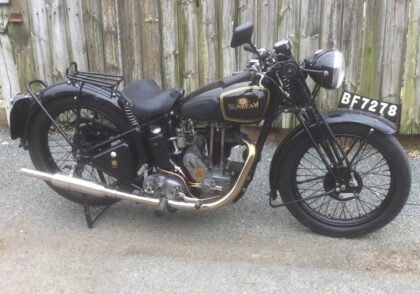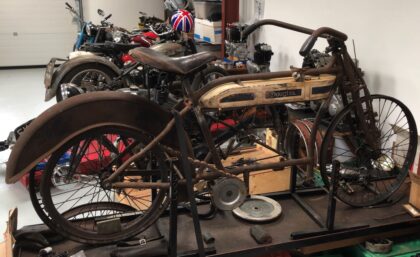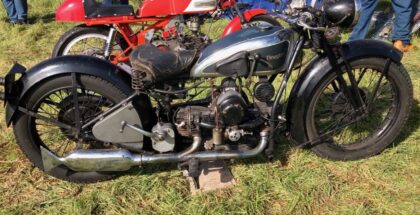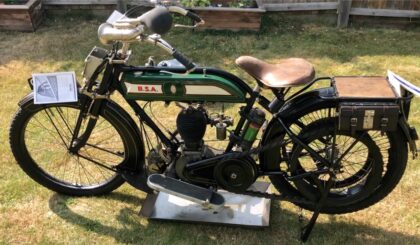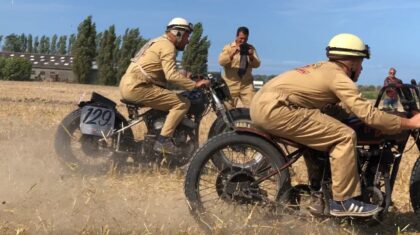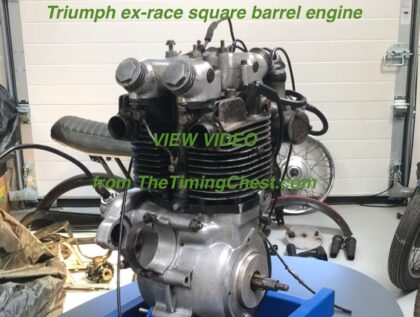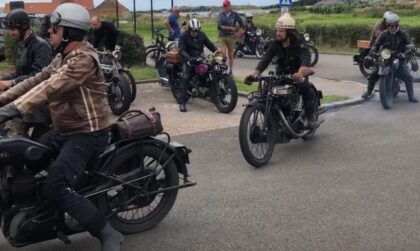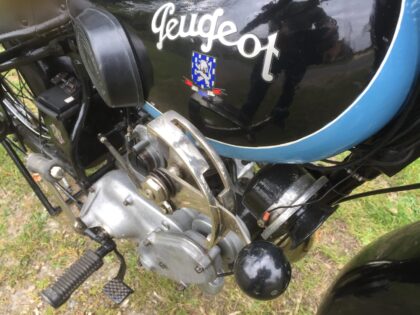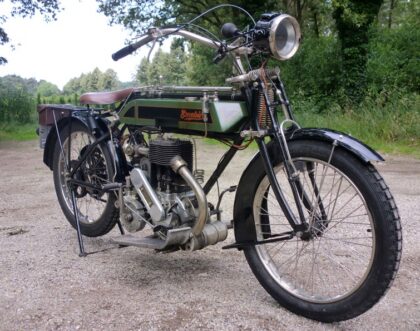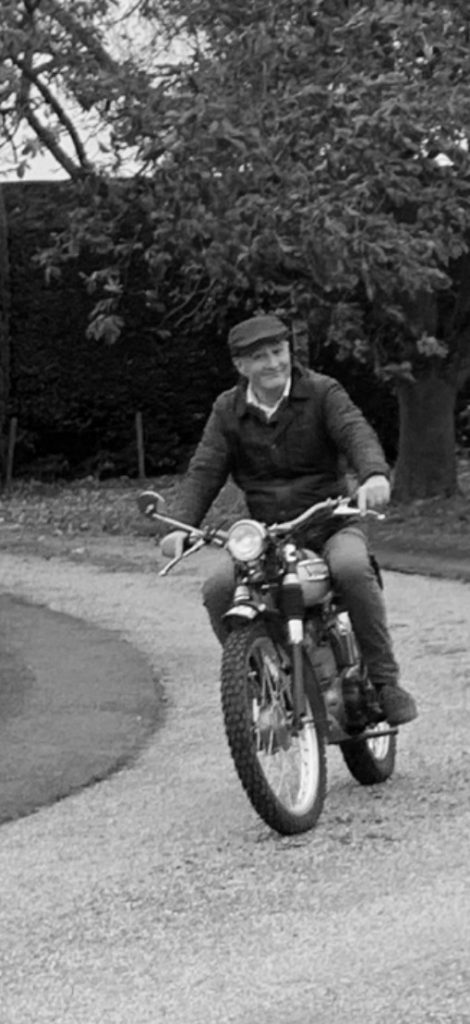Identify a JAP engine by the stamped numbers.
TheTimingChest.com
How to identify a JAP engine by the stamped numbers on the engine cases.
The early JAP engines were stamped on a numerical basis, with no help regarding the capacity. For example, engines prior to First World War, 1915, JAP engines had numbers up to 52,000. As a guide a June 1911 engine is recorded as having a 5-digit number beginning with 105**. It is also fairly accurate to say 60,000 onward is for 1916. The number stamps 70,000-on is 1917.
From 1920 JA Prestwich used a combination of numbers and letters to denote the year, cc, bore and stroke, number of cylinders, side valve or overhead valve, and some letters after the last oblique for any unique differences.
For all of the information to give you an accurate reading when trying to identify a JAP engine by the stamped numbers, you need to determine if the engine is produced before 1926 as the letters after the second oblique mean something else after the end of 1925.
In simple terms,
- The first digit (or 2 digits) is the engine size identifier.
- The next letter indicates the year of manufacture. See tables below. To confuse us more, they used the same letters in different eras.
- the long string of numbers between the obliques, is the unique number for this engine.
- Letters that come after the last oblique identify any specific details about the engine (such as whether it is a sports model, or if it was supplied with a Ball bearing gear spindle among many variations). See the list below.
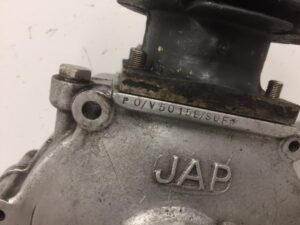
Identify a JAP engine by the stamped numbers
Confused?
You soon will be…..
Here’s an example: PO / V50158 / SOF* .To see this engine, visit my site here.
I have shown my references for this engine number in RED
PO = 250 cc. 62,5 x 80 mm
V = Year 1936
50158 is the unique production number
S = Engine was made to customer’s specification
O = (Here’s where it’s tricky) In tables prepared by others, they say that this letter in this position is for engines prior to 1926. My feeling is that JAP continued using most of the letters and their meanings after 1926. So, “O” would mean it had a specific cylinder type. In this case “Number 2”
F = Just like “O” above, the pre-1926 table refers to this engine having an Aluminium alloy piston with a domed top.
* = Engine has been specially prepared for something special like a speed attempt of just tuned to a rider’s needs.
So this is a 1936 J.A.P. 250cc OHV Engine, 62,5 x 80mm. Originally specially prepared by J.A Prestwich to customer specifications. The * denotes the special preparation, as does the “S” in the last three digits of the engine number.
Caveat: Ok, use your eyes! If it has an alloy domed top piston and it’s after 1925, then it’s still possible for the engine to have an “F” after the final oblique. It also seems that the full records are not available, so we need to bear in mind that this is simply a guide. There are some helpful design changes listed below, showing when major design changes were made.
Because JA Prestwich made so many engines, for so many uses, it’s not always easy to work out the year etc. My interest is solely in vintage motorcycles. The information on here primarily deals with how to identify a JAP engine by the stamped numbers for vintage and veteran motorcycles.
Side valves (SV):
V 175 cc. 60 x 62 mm. .
Z 175 cc. 55 x 73 mm.
N 200 cc. 55 x 83 mm.
B 250 cc. 64,5 x 76 mm.
A 300 cc. 70 x 78 mm.
I 350 cc. 70 x 90 mm.
K(Y) 500 cc. 85,7 x 85 mm.
L(Y) 550 cc. 85,7 x 95 mm.
U 600 cc. 85,7 x 104 mm
GT 680 cc. v-twin 50deg 70 x 88 mm.
MT 750 cc. v-twin 50deg 70 x 97 mm.
KT 980 cc. v-twin 50deg 85,7 x 85 mm.
KTCY 980 cc.(8/30) v-twin 50deg 85,7 x 85 mm.
LT 1100 cc. v-twin 60deg 85,7 x 95 mm.
DT 1323 cc. v-twin 60deg 90 x 104 mm.
Over head valves (OHV):
HO 175 cc. 53 x 78 mm.
TO 200 cc. 57 x 78 mm.
PO 250 cc. 62,5 x 80 mm.
POR 250 cc. racing 62,5 x 88 mm.
NOR 250 cc. racing 65,5 x 74 mm.
BOR 250 cc. TT racing 64,5 x 76 mm.
SOC 350 cc. sports 74 x 80 mm.
SOR 350 cc. racing 70 x 80 mm.
IOR 350 cc. racing 70 x 90 mm.
SOS 350 cc. grass track 74 x 80 mm., speedway or sprint.
JOS 500 cc. 80 x 99 mm. speedway or sprint.
YTO 500 cc. v-twin 60 x 88 mm.
KOC 500 cc. sports 85,7 x 85 mm.
KOR 500 cc. racing 85,5 x 85 mm.
JOR 500 cc. racing 80 x 99 mm.
PTOR 500 cc. racing v-twin 62,5 x 80 mm.
GTO 680 cc. racing v-twin 70 x 88 mm.
KTOR 980 cc. racing v-twin (8/45) 85,7 x 85 mm.
KTO 980 cc. (8/45) v-twin 62,5 x 80 mm.
JTOR 998 cc. racing v-twin (8/50) 80 x 99 mm.
JTO 998 cc. touring v-twin 80 x 99 mm.
JTOS 998 cc. sprint v-twin (8/80) 80 x 99 mm. speedway or sprint. A few of these were made with a dry-sump and the letters were JTOSZ
W/W 1100 cc. Mk1 racing v-twin ? x ? mm. Lubrication bt gear pump.
Production dates
(These ran from Sept the previous year until end of August)
P = 1920
N = 1921
E = 1922
U = 1923
M = 1924
A = 1925
T = 1926
I = 1927
C = 1928
S = 1929
W = 1930
H = 1931
Y = 1932
Z = 1933
D = 1934
R = 1935
V = 1936
F = 1937
O = 1938
G = 1939
Be careful with these year letters. In their infinite wisdom, JAP re-used them from 1940 to 1959 as follows:
P = 1940
N = 1941
E = 1942
U = 1943
M = 1944
A = 1945
T = 1946
I = 1947
C = 1948
S = 1949
W = 1950
H = 1951
Y = 1952
Z = 1953
D = 1954
R = 1955
V = 1956
F = 1957
O = 1958
G = 1959
After 1959
A = 1960
C = 1962
B = 1961
D = 1963
Remaining letters before first oblique:
T = Twin cylinder
0 = Overhead valves (cancels reference to side valve in preceding letter)
W = Water cooled
Z = Dry sump lubrication
S = Short stroke sports engine (or special)
C = Sports engine
R = Racing engine
Y = Twin exhaust port cylinder head
Letters after the engine serial number and second oblique
This apparently applies to engines made prior to 1926. However, some of these letters seem to work for engines made after this date. It’s worth noting that the letter S on an engine from 1926 denotes that it was made to customer’s specification.
The “*” that the engine has been specially prepared for something special like a speed attempt of just tuned to a rider’s needs. This is one of the hardest areas to determine specification when trying to identify a JAP engine by the stamped numbers. It’s best done with the engine in front of you as the following info mostly applies to items inside the crank cases.
A = High lift cam
B = Modified gear cover and exhaust lifter for rear drive 300cc and 350cc roadster.
C = Crankcase with inclined platform, Cologne Mke. Two stroke
D = Cast iron piston, flat top, fitted to standard engine
E = Cast iron, dished-top piston fitted to standard engine.
F = Aluminum alloy piston with domed top fitted to standard engine
G = Ball bearing gear spindle, when fitted as opposed to phosphor bronze
H = Roller bearing pulley spindle, when fitted as opposed to phosphor bronze or ball bearing
J = Roller-type cam levers and exhaust valve lifter to suit 500 / 600cc S.V.
K = Special chain line requirement for pulley spindle
L = Outside flywheel with screw-on sprocket, flange type, for two-strokes
M = Crankcase without oil box
N = Magneto sprocket for type NA magneto of ML manufacture (two-strokes)
O = Cylinder No. 2 type
P = Cylinder No. 4 type
R = Cylinder No. 3 type
S = Double row roller big-end bearing (250cc and 350cc ohv racing engines) *
T = New Type crankcase and rotary valve breather (500cc and 600cc side valve)
U = Modifications for new tappet centres (350cc side valve roadster)
V = Reduced centre connecting rods (low compression engine)
Y = 1924 pattern crankcase converted to rotary valve breather
A few notes on engine details that can assist with dating and not just identify a JAP engine by the stamped numbers.
- 1931. The script version of the JAP logo appeared.
- 1932. JAP brought in horizontal crankcase ribs.
- 1932. Enclosed pushrods in tubes with alloy rocker box
- 1932. Single exhaust port
- 1933. Engines had a right side downdraft inlet port
- 1933. Valve guide oil feed introduced
- 1933. Double Pilgrim oil pump
- 1933. The “Long Four” engine had a longer connecting rod and barrel.
- 1934. The driveshaft sprocket was splined
- 1934-36. Enclosed valve caps were introduced and developed
- 1935. 5-Stud engine
- After 1945. Cylinder head re-cast to eliminate the need for the 5-stud engine. (2-year overlap of 5-stud engines to 4-stud engines)
- Just after 1945 large fin alloy barrels available for use in rear engine race cars.
Stationary engines:
JAP also made stationary engines. I don’t have any info on them. there are a lot around and (initially) many are confused as motorcycle engines.
Here is a little information on some of the stationary engines:
Model 0 (34cc) Two Stroke
Model 2A (98cc)
Model 2S (98cc)
Model 4F (186cc)
Model 4/2 was 245cc, 2.4bhp @ 2400rpm, Wico Mag A576BZ.
Model 4/3 was 288cc, 3.5bhp @ 2400rpm, Wico Mag CJ936
Model 5 was 412cc, 4.5bhp @ 2200rpm, Wico Mag CJ936
Model 6 was 588cc, 5.5bhp @ 1800rpm, Wico Mag CJ936
Model 55was 824cc, 8bhp @ 2000rpm, Wico Mag.
View JAP engines and parts for sale here
Contact:
If you need some help to identify a JAP engine by the stamped numbers, please contact me with the numbers. I will do my best. However, I can only help with motorcycle engines.
If you aren’t already a member, you might wish to consider joining the Vintage Motorcycle Owner’s Club. There are marque specialists available to guide you with dating your motorcycle and more.
